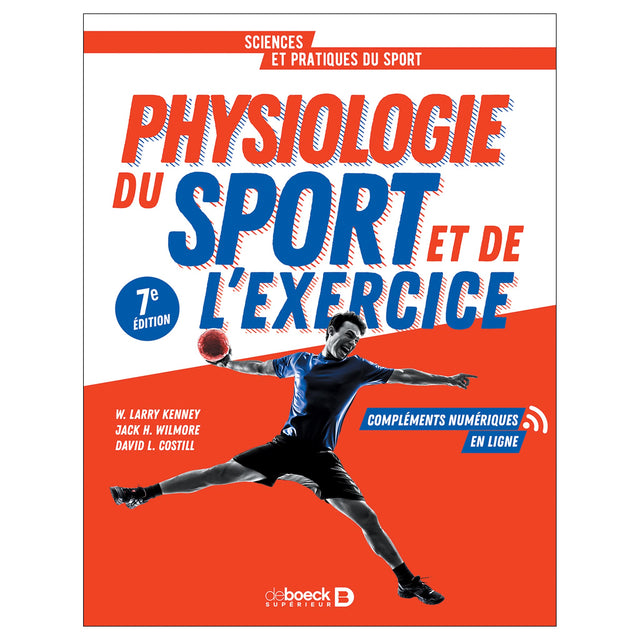Physiologie du sport et de l’exercice 7e
$59.00 CAD
Cette 7e édition conserve les qualités des éditions précédentes :
- pédagogie efficace,
- structuration des chapitres très claire,
- écriture simple et directe adaptée aussi bien aux étudiants qu’aux enseignants,
- illustrations en couleur.
- mots-clés en fin de chapitre
- résumés encadrés rappelant tous les points fondamentaux.
- tests des connaisances à la fin des chapites,
- références bibliographiques numérotées tout au long du texte destinées à apporter des informations supplémentaires sur les sujets abordés.
- glossaire
Audience
Available in Canada only. Ce manuel est destiné aux étudiants en physiologie de l’exercice de premier cycle. Il s’agit d’un ouvrage de référence pour les étudiants diplômés et les scientifiques œuvrant dans le domaine, les spécialistes de la médecine sportive, les physiciens, les entraîneurs, les kinésithérapeutes, les thérapeutes du sport et les spécialistes du conditionnement physique.Avant-propos
Remerciements
Chapitre 1. Introduction à la physiologie du sport et de l’exercice
Partie 1. L’exercice musculaire
Chapitre 2. Structure et fonctionnement musculaire
Chapitre 3. Métabolisme et bioénergétique musculaire
Chapitre 4. Le contrôle nerveux du mouvement
Chapitre 5. Régulation hormonale de l’exercice
Chapitre 6. Dépense énergétique, fatigue et douleurs musculaires
Partie 2. Fonctions cardiovasculaire et respiratoire
Chapitre 7. Le système cardiovasculaire et son contrôle
Chapitre 8. Le système respiratoire et ses régulations
Chapitre 9. Régulation cardiorespiratoire à l’exercice
Partie 3. L’entraînement physique
Chapitre 10. Principes de l’entraînement physique
Chapitre 11. Adaptations à l’entraînement de force
Chapitre 12. Adaptations à l’entraînement aérobie et anaérobie
Partie 4. Influence de l’environnement sur la performance
Chapitre 13. Thermorégulation : L’exercice en environnement chaud ou froid
Chapitre 14. L’exercice en altitude
Partie 5. Optimisation de la performance
Chapitre 15. Programmation de l’entraînement
Chapitre 16. Composition corporelle, nutrition et sport
Chapitre 17. Sport et pratiques ergogéniques
Partie 6. Activité physique et sport en fonction de l’âge et du sexe
Chapitre 18. Activité physique et sport chez l’enfant et l’adolescent
Chapitre 19. Activité physique et avance en âge
Chapitre 20. Les différences intersexes dans les activités physiques et sportives
Partie 7. Activité physique et santé
Chapitre 21. Aptitude physique et santé : la prescription d’activité physique
Chapitre 22. Activités physiques et maladies cardiovasculaires
Chapitre 23. Obésité, diabète et activités physiques
Glossaire
Références bibliographiques
Index
Au sujet des auteurs
Abréviations, unités et conversions
Auxiliaires Français
GRATUIT à instructeur. Comprendre: PowerPoint présentation. Disponible par email: Info@hkcanada.com
English Supplementary Instructional Materials
Ancillary materials for this text are FREE to course adopters and available online. Materials include:
Instructor guide. Includes sample lecture outlines, key points, and student assignments for every chapter in the text, along with sample laboratory exercises and direct links to a range of detailed sources on the Internet.
Test package. Features a bank of 1692 questions, including true-or-false, fill-in-the-blank, essay and short-answer, and multiple-choice. The test package is available for use through multiple formats, including a learning management system, Respondus, and rich text.
Chapter quizzes. Contains 10 to 11 questions per chapter that instructors can use in their lessons to gauge student comprehension. Compatible with learning management systems, these quizzes offer easy grading and record keeping for instructors.
Presentation package plus image bank. Includes 1198 PowerPoint slides of text, photos, and artwork from the book that instructors can use for class discussion and illustration. The slides in the presentation package can be used directly in PowerPoint or can be printed to make transparencies or handouts for distribution to students. Instructors can easily add, modify, and rearrange the order of the slides as well as search for slides based on key words. The image bank includes most of the illustrations, artwork, content photos, and tables from the text, sorted by chapter to provide instructors with flexibility when creating their own resources, including customized presentations, handouts, and other course resources.
Animations. Brings 26 images and figures from the text to life through animation, providing an exciting way to experience course material. Instructors will be able to access the animations from a centralized location for easy reference and use in classes and lectures. The animations are also included in the web study guide for student access.
Video clips. Includes 27 videos from key leaders in the field discussing recent developments and real-world applications. Instructors will be able to view all video clips from a centralized location and incorporate them into classes and lectures. The video clips are also included in the web study guide for student access.
Audio clips. Includes 66 audio clips that provide explanations of complex physiological processes to aid students’ understanding of important illustrations in the text. Instructors will be able to access all audio clips from a centralized location and incorporate them into classes and lectures. The audio clips are also included in the web study guide for student access.





